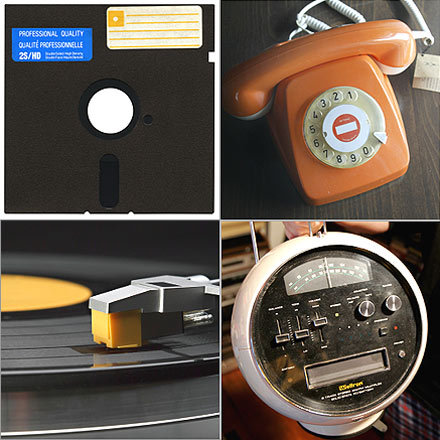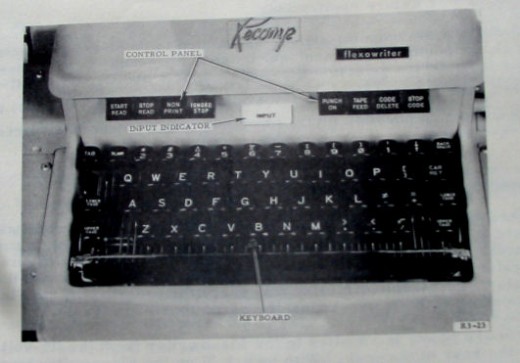What Happened to All That Stuff?

What happened to all that stuff? There are millions of products that are now unsaleable because they've been replaced with something newer and better. There are warehouses full of obsolete technology. The American culture and marketing techniques thrive on planned obsolescence. What happened to all that stuff? What happened to...
- Typewriters
- Flash bulbs
- Camcorders
- LP Records
- 8-track tapes. Remember those?
- Cassette tapes
- Reel-to-reel recording equipment
- Phone cords
- Video Tapes
- Mimeographs
- Film
- Manual Channel Changers on TV's
- Floppy Diskettes
- Teletype Machines
- Transistor Radios
What has happened to all that stuff; things that were new twenty years ago and are still sitting, unused and unsold, on a shelf somewhere because they got replaced with something else before they all could get sold? What has happened to all the perfectly good stuff sitting in people's attics and garages; electronics that still work...(your Commodore computer?)...toys, games, all manner of phone equipment...what has happened to all that stuff?

All lthat stuff cost money to make and used up resources. What happened to it? What is it actually worth now, compared to the time, labor and resources that went into making it? Is all that stuff just wasted?
I don't think it used to be a problem. People didn't look around to replace what they had until it was broken beyond repair or used up. It was a simple matter of personal economics.
Now, it's another story. We've got a Pavlovian response going. To keep up with the ever-increasing pace of technological advances, we buy the latest thing long before the old thing has outlived its usefulness.
We have warehouses full of floppy diskettes sitting around. Crates and boxes and cartons of floppy disks that no one is ever going to buy, representing hundreds of thousands of dollars.
We have further warehouses full of LP recordings, sitting there, cased neatly and stacked on pallets and gathering dust, for the last forty years.
We have even more warehouses full of cameras that operate using film. Yeah, that's right-film. Remember when you had to take the film in to get it developed?
The digital revolution outpaced especially the photography and music industries. They both have tons, literally tons of stuff tied up in dead inventories the world over. The bigger stuff--computers, copiers, fax machines, televisions, are still a huge problem of overproduction of stuff that's obsolete, given the pace of technological advances.
What happened to all that stuff? It didn't just disappear. It's stil on the books, in most cases, even though the company has no hope at all of liquidating it or selling it retail.

Maybe you're thinking, so what? Oh, well. Tough nuggets, big deal. You have a few things sitting in your basement that are in working order but obsolete.
Not only in your basement. There are literally warehouses, all over the world, filled to the rafters with un-dead electronic equipment and peripherals.
Here's the kicker. The business who own this inventory that is no longer marketable don't write it off. It stays and stays and stays on their books. They show it as "live" inventory and saleable products. They do this in order to get business loans and to rescue the value of their capital stock (if it's a publicly traded company) when this inventory is rendered obsolete by something new. They don't just suddenly (or even gradually) write off ten or fifteen million dollars worth of inventory. The stock would drop as the profits went down and the shareholders lost faith.
The book value, and therefore the market value (though not directly corresponding) shows an inflated value of what the company is worth. Stockholders are mis-informed about the net profits, since none of the un-dead inventory is written off. The actual value of the inventory is much, much lower, because it includes so much merchandise that is unsold and obsolete, which will never be sold. It only has salvage value, if any, at maybe 2 or 3 cents on the dollar for what is listed. The books don't reflect this.
Instead, it all stays on the books. There might be about 300 billion dollars worth of outmoded merchandise sitting in warehouses, virtually unsaleable due to technological advances from the last five years . And it's all still on the books. And it's all still part of the market value of any tech stock you buy.
Where DID this number, 300 billion dollars, come from? I read two books on planned obsolescence and obsolete technology. The first was the better-researched, published two years ago, putting the number at about 100 billion. The second, which was published 3 months ago, put the number at 1.2 trillion dollars. I thought the second book was overstating the case and wasn't sure I trusted the author's research. I'm not saying any of those numbers, including my own, are correct--I definitely have the idea that no one can say for certain.
I can't imagine what's ultimately going to happen to all this STUFF! Can you? If it all suddenly was disposed of, it would cause a recycling nightmare! And that would be secondary to the stock market crash.

If you want MORE, click HERE:
- Corporate Globalization and Corporate Greed
Coporate Globalization--Yes, it's true--the world is owned and run by the super-wealthy. Even since Ann Rand's "Atlas Shrugged", there has been a conspiracy theory that basically, all the world is owned and run by a select consortium of ultra-wealthy - The Value of Money
What is the American dollar worth? The true facts about the value of money--everything you wanted to know and more.









